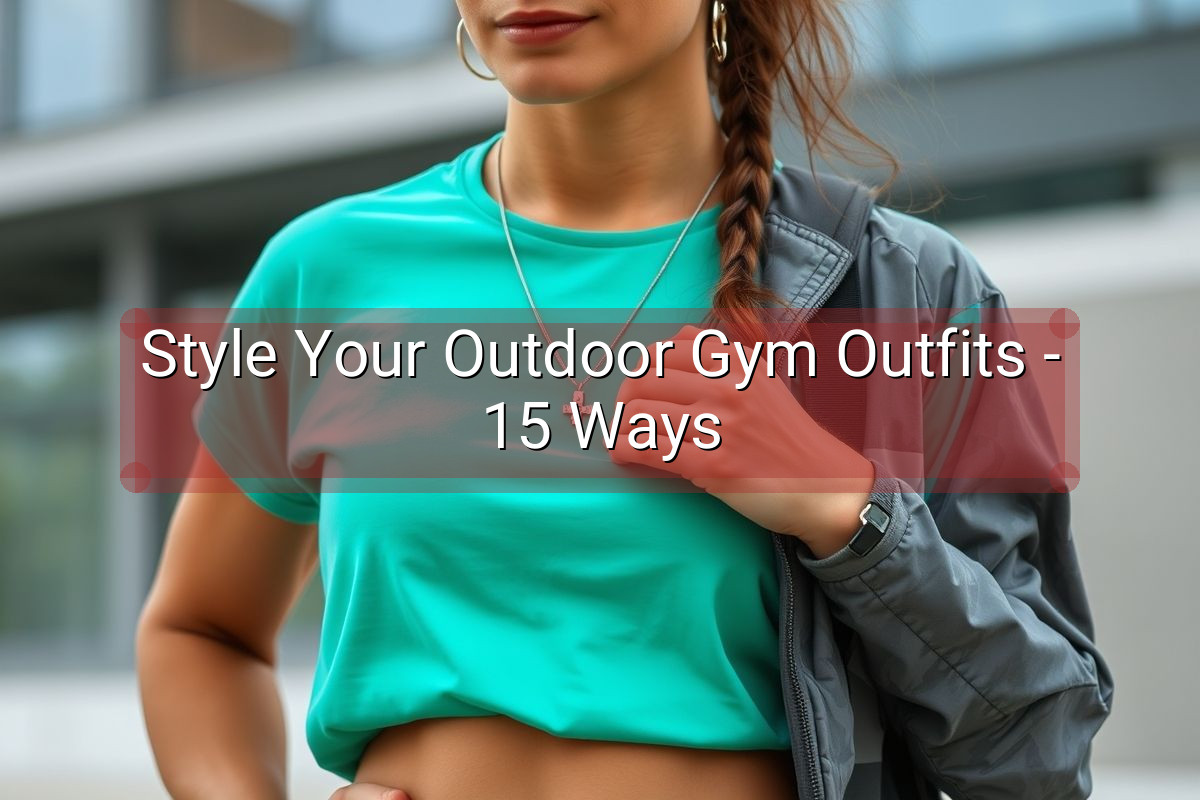Style Your Outdoor Gym Outfits – 15 Ways
Stepping into the fresh air for a workout is invigorating, but looking good while doing it can boost your motivation even further. Outdoor workouts offer unique challenges and opportunities when it comes to what you wear. From battling the elements to maximizing comfort and movement, finding the right outdoor gym outfit is key. This comprehensive guide offers 15 practical and stylish tips to help you curate the perfect outdoor workout wardrobe, ensuring you feel confident and prepared to conquer any fitness challenge nature throws your way. Whether you’re hitting the trails, practicing yoga in the park, or strength training on the beach, we’ve got you covered. Let’s dive into the world of stylish and functional outdoor gym attire.

Layering for Success
The Base Layer: Moisture-Wicking Essentials
Your base layer is the foundation of your outdoor gym outfit. Opt for moisture-wicking fabrics like polyester or nylon to keep sweat away from your skin. This helps regulate your body temperature and prevents discomfort during intense workouts. Look for breathable materials that allow air to circulate, keeping you cool and dry.
Consider the weather conditions when choosing your base layer. In colder temperatures, a thermal base layer will provide added warmth. For warmer weather, a lightweight, sleeveless top or tank top is ideal. Choose a fit that is snug but not restrictive, allowing for a full range of motion.
Different activities may require different base layer styles. For yoga or Pilates, a fitted tank top or sports bra may suffice. For high-impact activities like running or HIIT, a compression top can provide added support and reduce muscle fatigue.
The Mid-Layer: Warmth and Insulation
The mid-layer is designed to provide insulation and trap warm air close to your body. Fleece jackets, lightweight sweaters, or hoodies are excellent choices for this layer. Look for materials that offer breathability while still providing warmth.
Adaptability is key when choosing a mid-layer. Look for items that can be easily removed and tied around your waist if you start to overheat. Zip-up hoodies or jackets offer the most versatility.
The thickness of your mid-layer will depend on the temperature and the intensity of your workout. For colder weather, opt for a thicker fleece or insulated jacket. For milder temperatures, a lightweight sweater or sweatshirt may be sufficient.
The Outer Layer: Protection from the Elements
The outer layer shields you from wind, rain, and other elements. A waterproof and windproof jacket is essential for outdoor workouts in unpredictable weather. Look for jackets with breathable membranes to prevent overheating.
Consider features like adjustable hoods, cuffs, and drawstrings to customize the fit of your outer layer. These features can help keep out wind and rain, ensuring you stay dry and comfortable.
Packable jackets are a great option for outdoor workouts. They can be easily folded and stored in a backpack or gym bag when not in use.
Choosing the Right Bottoms
Shorts for Warm Weather Workouts
Shorts are the go-to choice for warm weather workouts. Look for styles that offer a comfortable fit and allow for a full range of motion. Moisture-wicking fabrics are essential to keep you cool and dry.
Consider the length and style of your shorts based on your activity. Running shorts typically have a shorter inseam for greater freedom of movement. Training shorts may have a longer inseam and offer more coverage.
Look for features like built-in liners, pockets, and adjustable waistbands for added comfort and functionality.
Leggings and Tights for Cooler Temperatures
Leggings and tights provide warmth and support during cooler weather workouts. Look for styles made from moisture-wicking and insulating fabrics. Compression tights can also help improve blood circulation and reduce muscle fatigue.
Consider the thickness of your leggings based on the temperature. For colder weather, opt for fleece-lined or thermal leggings. For milder temperatures, a standard pair of leggings may be sufficient.
Choose a fit that is comfortable and allows for a full range of motion. High-waisted leggings can offer added support and coverage.
Accessorizing Your Outdoor Gym Look
Footwear: Support and Traction
Proper footwear is crucial for outdoor workouts. Choose shoes that offer adequate support and traction for your chosen activity. Trail running shoes are ideal for uneven terrain, while cross-training shoes offer versatility for a variety of activities.
Consider the weather conditions when selecting your footwear. Waterproof shoes are essential for wet or muddy conditions. For warmer weather, breathable shoes with good ventilation are important.
Ensure your shoes fit properly and offer adequate support for your arches. Ill-fitting shoes can lead to discomfort and injuries.
Hats and Sunglasses: Sun Protection
Protecting yourself from the sun is essential during outdoor workouts. A wide-brimmed hat or baseball cap can shield your face and neck from harmful UV rays. Sunglasses protect your eyes and reduce glare.
Choose sunglasses with UV protection and a comfortable fit. Polarized lenses can further reduce glare and improve visibility.
Look for hats made from breathable materials that will keep your head cool and dry.
| Item | Benefit |
|---|---|
| Moisture-Wicking Base Layer | Keeps you dry and comfortable |
| Insulating Mid-Layer | Provides warmth in cooler temperatures |
| Waterproof Outer Layer | Protects you from the elements |
- Choose moisture-wicking fabrics.
- Layer your clothing for adaptable warmth.
- Select appropriate footwear for your activity.
